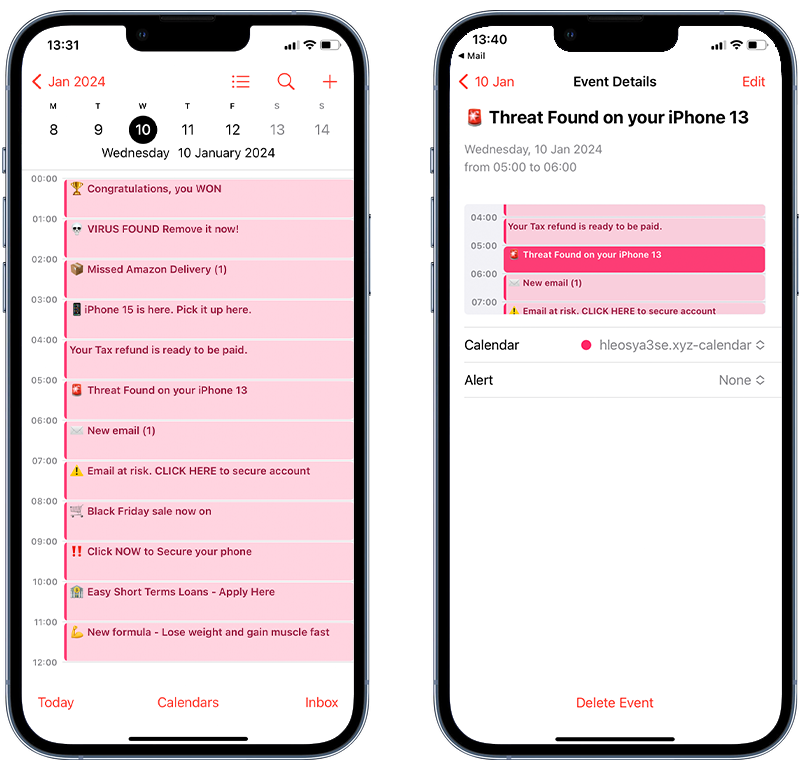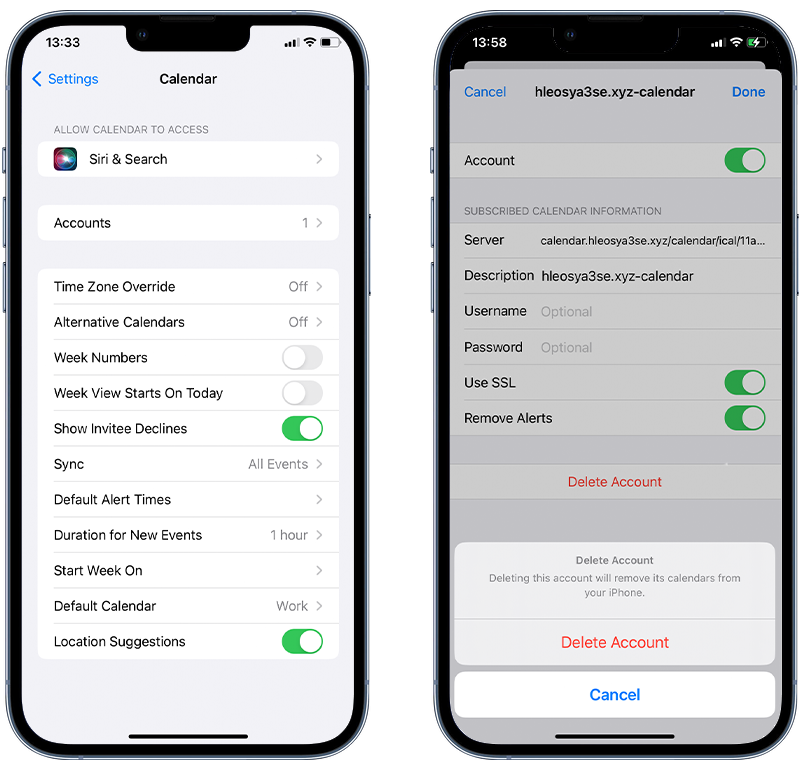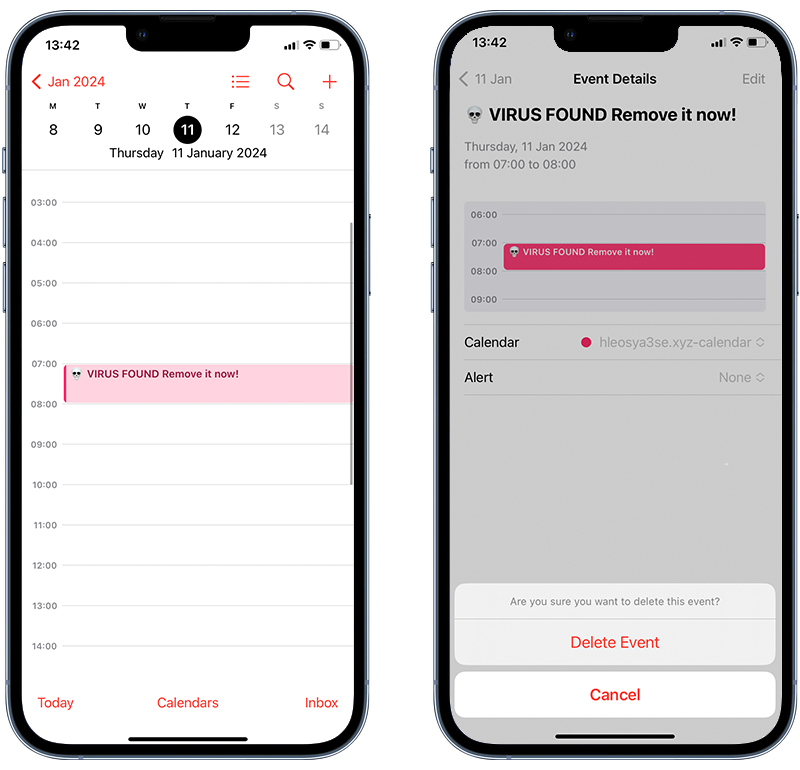How To Get Rid Of The iPhone Calendar Virus

By Simon Lewis
Published:

If you’re an iPhone user, you might have encountered a frustrating problem recently: the iPhone calendar virus.
This virus causes unwanted calendar events and alerts to flood your phone, disrupting your day and causing unnecessary stress. It’s not just annoying—it’s a sign that your phone’s security could be compromised.
If you’re concerned that your calendar has been hacked, don’t worry! In this article, we tackle this problem head-on.
We’ll start with a clear, easy-to-follow guide on how to remove these annoying calendar events from your iPhone. This guide is designed to be easy for anyone to follow, regardless of how tech-savvy they are.
After we cover the removal process, we’ll take a step back and explain what this virus is and how it typically gets onto iPhones.
You’ll learn about the signs to watch out for and how to protect your phone from similar issues in the future. By the end of this article, you’ll know how to get rid of this current annoyance and keep your phone safe moving forward.
Let’s get started and get your iPhone calendar back to normal.
Calendar Spam: Step-by-Step Removal Guide
Dealing with the iPhone calendar spam virus can be frustrating, but the good news is that removing it is straightforward. Here’s a simple guide to get your calendar back to normal:
Step 1: Identify the suspicious calendar
- Open the Calendar app on your iPhone.
- Look for any events that you don’t recognize, especially those that seem spammy or irrelevant.
- Check which calendar these events belong to. You can find this within the event details.

Fig 1. Identifying the suspicious calendar on iPhone.
Step 2: Remove the unwanted calendar subscription
- Open iPhone Settings.
- Scroll down and select Calendar.
- Tap on Accounts.
- Look through the list of accounts for any you identified in step 1 or that are unfamiliar. These could be under Subscribed Calendars or similar sections.
- Delete suspicious accounts by tapping them and selecting Delete Account.

Fig 2. Deleting a spam calendar on iPhone.
Step 3: Check for remaining Issues
- Return to your Calendar app to see if the unwanted events are gone.
- If some events are still there, you might need to remove them manually. You can open each event and select Delete Event.

Fig 3. Removing individual events from iPhone calendar.
Step 4: Secure your iPhone
Some calendar viruses can introduce malware onto your iPhone if you follow links or download anything from the spam events. This can lead to data from your device falling into the wrong hands.
It’s therefore worth downloading a good security app to check your iPhone for other issues once you have safely removed the calendar from your device.
Keep Your iPhone Secure
Protect your iPhone from cyberthreats with Certo for iPhone. Download for free today.
Step 5: Stay alert
Be cautious about the links you click on and the calendar invites you accept in the future. Regularly check your subscribed calendars and accounts in the Calendar and Settings apps.
Contrary to its name, the iPhone calendar virus is not a traditional virus, but a type of calendar spam that exploits how iPhones handle calendar subscriptions. It’s important to understand how it works to better protect yourself in the future. That’s exactly what we’re going to do below!
What Is iPhone Calendar Spam?
Now that you know how to remove calendar spam from your iPhone, let’s dive deeper into this issue and how it typically affects devices like yours.
This problem arises when your iPhone gets subscribed to a malicious calendar. It typically happens after clicking a suspicious link or ad, often unintentionally.
The result is a series of bogus calendar events that populate your iPhone’s Calendar app. These can range from ads for products to fake warnings or event invites.

Fig 4. Subscribing to spam calendar on iPhone.
💡 Common Examples of Calendar Spam Messages
➡️ Click NOW to Secure your iPhone
➡️ iPhone 15 is Here; pick it up or Rearrange delivery
➡️ Easy Short-Term Loans – Apply Online
➡️ Your iPhone Has Been Infected with a Virus! Remove it now
➡️ Congratulations, you won!
➡️ Black Friday Sales – ACT NOW
➡️ CLICK SUBSCRIBE
➡️ You have (1) Pending Package
How does it infect iPhones?
iPhone calendar viruses often begin with deceptive invites, often from email addresses obtained by hackers. Email addresses are usually sourced from two places: scam websites that sell your personal details or companies that have experienced a data leak.
By default, Apple’s Calendar app allows anyone to send invitations. This openness, unfortunately, increases the risk of vulnerabilities being exploited. Hackers leverage this feature to send phishing links embedded in fake events, typically hosted on a spam calendar.
Another common method of infection involves fake captchas on dubious websites. These captchas, designed to mimic standard bot-checking puzzles, can actually trigger accidental subscriptions to fake calendars.
When you attempt to confirm you’re not a robot through the captcha process, you might unknowingly agree to these subscriptions, leading to your iPhone calendar being cluttered with false events and suspicious links.
Lastly, be cautious of spam text messages containing links, such as a prompt to track a parcel. Clicking these links can inadvertently subscribe you to a spam calendar, filling your iPhone with fake appointments and misleading warnings.
Symptoms to look out for:
⚠️ Unexpected calendar events: The most obvious sign is the appearance of strange events in your calendar account. These might include odd titles, suspicious URLs, or nonsensical descriptions.
⚠️ Frequency of events: The spam events might occur frequently, cluttering your calendar and notifications.
⚠️ Unrecognizable spam calendars: Finding calendars in your list that you don’t remember subscribing to is a red flag.
Understanding the nature of this issue is key to preventing future occurrences. It’s less about a flaw in the iPhone itself, and more about deceptive practices used by spammers and cybercriminals.
By being aware of how the iPhone calendar virus operates, you can be more vigilant and better equipped to protect your device.
How iPhone Calendar Spam Affects Your Apple Devices
Understanding the impact of the iPhone calendar virus on your device is crucial. This isn’t just about annoying spam—it can affect your iPhone’s functionality and your overall experience.
Disruption
Constant notifications from spam events can be distracting and disrupt your daily routine. Also, your calendar may become cluttered with spam events, making it hard to track your actual appointments and schedules.
Privacy and security concerns
While the spam itself may not steal personal information, clicking on links within these events can lead to phishing sites or other malicious web pages that threaten your privacy.
If not addressed, this kind of spam can potentially lead to more serious security issues, especially if it encourages users to click on infectious hyperlinks or download a malicious app.
If a malicious app makes it onto your iPhone, your personal data could be at risk. If you’re worried, we recommend running a virus scan as soon as possible to remove any threats.
Increased vulnerability
Continuously dealing with this type of spam can make users less vigilant, potentially increasing their susceptibility to more dangerous types of malware or phishing attempts.
By understanding these impacts, you can appreciate the importance of removing the spam and taking steps to prevent future occurrences.
The next section will guide you on safeguarding your iPhone against the calendar virus.
Remove malicious iPhone apps
Use the award-winning Certo AntiSpy to detect and remove malware, spyware and other threats from your iPhone.
How to Prevent iPhone Calendar Spam
To minimize the risk of malware and spam in your iPhone calendar, follow these essential tips:
1️⃣ Block pop-ups in Safari
Safari, being the default browser on iOS, is often the gateway for privacy and security threats. Malicious pop-ups in Safari can lead to spam messages and notifications.
Accidentally clicking on these ads may result in spam events appearing in your calendar.
Here’s how to block pop-ups:
🔺 On iPhone/iPad: Go to Settings > Safari. Toggle on Block Pop-ups and Fraudulent Website Warning.

Fig 5. Blocking popups and enabling warnings for fradulent websites.
🔺 On Mac: Open Safari and go to Preferences. Under the Websites tab, set your preferences to block pop-up windows. In the Security tab, activate Warn when visiting a fraudulent website.
2️⃣ Be cautious with links and attachments
We’ve said this many times. Don’t tap links or open attachments in unfamiliar text or email messages. Also, be cautious when dealing with captchas, as they can sometimes be deceptive.
If you receive a suspicious iPhone calendar notification, delete it without interacting. For text messages in the Messages app, swipe right to left and select Delete. You can also Report Junk if prompted.
3️⃣ Update calendar settings for better security
Tightening your calendar settings starts with keeping your calendar free from spam and malicious events.
By adjusting a few key preferences, you can enhance the security of your calendar and reduce the risk of unwanted spam. Here’s how:
- Log in to your iCloud account and tap Calendars.
- Click the gear icon in the bottom left, select Preferences, then go to the Advanced tab.
- In Invitations, choose Email to [your email address] instead of In-app notifications to receive invites via email, reducing the risk of direct calendar spam.
4️⃣ Keep your email private
Finally, be selective about who you give your email address to, as it can be used to send calendar invites.
💡 Pro Tip: Consider a Secondary Email. Use a separate ‘burner’ email for subscriptions and non-essential contacts to keep your primary email and calendar clutter-free.
Final Thoughts
The iPhone calendar virus, while not a traditional virus, can be a significant nuisance and potentially pose a security threat. This guide has walked you through the steps to remove this calendar spam and helped you understand its nature and impact.
More importantly, we’ve shared crucial tips on preventing future occurrences, along with steps to recover and protect your iPhone.
Staying vigilant and informed is essential. Regularly updating your device, being cautious about links and invitations, and maintaining strong security settings are more than just best practices—they are necessary. Beyond these steps, consider using specialized software for added protection.
Certo AntiSpy can be a valuable ally in your cybersecurity arsenal. It’s designed to detect and prevent various types of spyware and threats on your iPhone, offering peace of mind.
By following the advice outlined in this article, you can ensure that your iPhone, particularly your calendar, remains a tool for organization and productivity, and doesn’t become a source of stress.